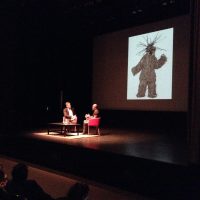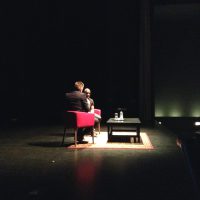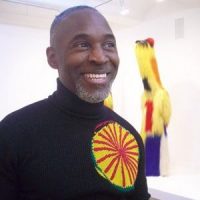On May 28, 2015, American artist Nick Cave presented the second Contemporary Conversations lecture, an exciting new artist exchange program for Art in Embassies(AIE) , set to feature a total of seven American artists over the course of the next two years. The program is presented in partnership with U.S Embassy Ottawa and the National Gallery of Canada (NCG). This initiative is an integral part of extending the reach of the Art in Embassies exhibition at Lornado, the residence of the American Ambassador to Canada, by using the art and artists on display at the residence, as a means of generating open dialogue across cultures and enriching the scope of U.S. public diplomacy.
With the NCG’s auditorium almost at full capacity, the evening began with opening remarks by AIE Director Ellen Susman and Mrs. Vicki Heyman, wife of U.S. Ambassador Bruce Heyman. Following the opening remarks, Cave engaged in a lively conversation with Jonathan Shaughnessy, NCG’s Associate Curator of Contemporary Art. The audience was presented with an in-depth look at Cave’s artistic practice through the lens of several examples. Showing images and a new video of his iconic Soundsuits, the artist explained how these works, at once both sculptural and performative, stemmed from his own research of ceremonial and ritual costume dress from around the world. He also spoke of the monumental site specific AIE commission and Artist Exchange he completed for the U.S. Embassy in Dakar, Senegal in 2014, noting how the process of developing relationships with and learning from members of the local community were integral to the final product. Following the lecture at the NGA, a dinner was held at the Ambassador’s residence honoring the artist and his work.
0:11Hello, I’m Jonathan Shaughnessy associate curator for contemporary art at the
0:14National Gallery of Canada.
0:15And this morning I’m at the US Ambassador to Canada is residence Lornado.
0:19And I’m in front of Nick Cave’s sound suits,
0:23the celebrated American chicago-based artist is here today
0:27as part of the Art in Embassies program organized by the US Embassy
0:31in collaboration with the National Gallery of Canada. I will be speaking to Nick Cave
0:36this morning about aspects of his work and the sound suits
0:39in which you see one behind me.
0:48Good morning Nick.
0:49Good morning, how are you?
0:50I’m well, I’m well
0:52We’re here to talk about your work and the evolution perhaps mainly as the work the best
0:59known for which are yours
1:00sound suits and we have one behind us.
1:04The sound suits strike me strike many people I’m sure is full of colorful and
1:08joyful love life
1:10but the evolution or at least the instigation of
1:14the sound suits come from perhaps a more tragic and darker place and was
1:17wondering if you can speak about
1:18the first sound suit and where it came from.
1:20Yeah, you know the sound suit originated from the Rodney King incident
1:28LA riots in 1992.
1:31And so it was, what I was responding to was just what I was reading,
1:38in terms on how they brought description to Rodney King’s character.
1:42You know, this man as
1:45someone that was scary larger-than-life,
1:49worked out with prison weights,
1:52took 10 men to bring him down and i was just invisioning
1:56in my head, what would that look like. And then started to think about
2:02you know myself as a African-American male and that
2:07you know, I to can be profiled.
2:11So then that led me to think about
2:15feeling sorta insonificate, less then
2:21dismissed and
2:24that in those ideas I start to shift in to looking at materials.
2:29And I happened to be in the park one day and
2:32was sitting there and there was this twig on the ground
2:36which I looked at and sort of,
2:39what came to mind it was just something that I
2:43you know dismiss, discarded you know I don’t
2:46really give it much attention and started then to proceed together,
2:52this abundance of twigs
2:56and that was the beginning of building this sort of sculptural form.
3:00And once I built this sculpture
3:04I realize I could physically put it on and then once I put it on it may
3:09sound. And so that was the beginning of
3:13sound suit. And sound, once I started to move in it, I realized that
3:20I started to think about the role a protest in
3:22in order to be heard you got to speak louder and
3:26just this aggressiveness that is applied
3:30to that and
3:33things started to evolved more and more through this sort of
3:37discovery and and the sounds suit,
3:41you know, at one point completely sort of
3:44remove my entire sorta gender race and class.
3:49Then I was forced to look at this object without judgment,
3:52so it really started to continue to sorta build
3:56this amazing sorta
3:59image of association
4:04to all of these feelings that I was sorta struggling with.
4:09There’s less distinctions maybe in worrying about
4:11whether this is a sculpture or costume
4:12and you work seems to be all about those kinda crossovers between
4:16art and fashion, between craft and art, all these kinds of things that
4:20a seem to just be about the mess of life that can be beautiful, could be tragic.
4:24Well in you know I have to also sorta pay attention to what,
4:28you know I was surrounded by as a kid, you know I come from,
4:32you know grandparents that were like grandmothers that her
4:36amazing quilters, my mother comes from a family and 16.
4:41They’re like amazing seamstresses in that, that bringing my grandfather’s
4:46where amazing sorta woodworkers and furniture designers and so.
4:50You know I’m being sorta surrounded by all of these
4:54sorta amazing, sorta craft,
4:58sorta skills and,
5:01this sorta of creativity that has allowed me to think about
5:06you know the importance of that. Now I’m interested in the high art, low art
5:12what, how we tend to sort of talk about that.
5:15Is that really, I’m not sure there’s
5:19really the sorta separations or
5:25distinctions that have to be separated as opposed to you know how do they
5:31sorta merged together and sorta become part
5:35of a practice.
5:38And you been described in sort along with that I think trying to pin you down,
5:43a artist, a sculptor, a designer, a fashion designer.
5:47I have read many descriptions for you as an artist, as a person.
5:52But you refer to yourself as a messenger,
5:55at least I read and I’m wondering if you can may be described that and
5:59for Canadian audience maybe if you thought about the message your bringing to Canada being here.
6:05You know I think, you know I think that
6:11I think the reason why I see myself as a messenger because I want to
6:14use my art as a vehicle for change.
6:16It then allows me
6:20to then sorta focus
6:24on again, how I sorta become an advocate
6:27and instigator in terms of building
6:31work based on the sorta support of
6:34community. And
6:39the purpose of that is to sorta
6:42diversify and to bring people together that tend to don’t
6:47even realize that they live in the same place and how can I sorta
6:50again be part of building that sorta level of awareness.
6:55And you know, I’m not doing this work for me, so I think
7:00that, you know what I want the work
7:04to do and how I want the work to be sorta impactfull and to be
7:09and sorta employed is that
7:13it’s really about getting us back to the sorta
7:16imaginary sorta state of mind.
7:19You know we tend to exist in the world today where
7:23we’re not really thinking, we don’t really think about
7:27our dreams and aspirations were all sorta
7:31consumed by you know, job security which is
7:35not there anymore and and so it’s a different kinda mind set, but I think
7:40it’s important for us to continue to sort have
7:42these aspirations about what we
7:46would like to be and how we would like to be in the world.
7:50And if I can be part of that,
7:54be the catalyst that through
7:57this kind of work that’s really but the goal is.





